CRIMES OF MORAL TURPITUDE QUICK REFERENCE CHART
For; Immigrant Legal Resource Center
QUICK REFERENCE CHART
For Determining Key Immigration Consequences
Of Selected California Offenses
DEFINITION OF TERMS
USC, LPR, Undocumented. In these materials, a United States citizen is referred to as a USC, a lawful permanent resident (“green card” holder) is referred to as an LPR, and a person with no current lawful immigration status is referred to as an undocumented person. For more information on these and other forms of immigration status, see Note: Overview and Note: Relief Toolkit.
Aggravated Felony (AF). This conviction generally brings the worst immigration consequences. The AF definition at 8 USC § 1101(a)(43) includes twenty-one provisions that describe hundreds of offenses, including some misdemeanors. Some but not all offenses require a sentence imposed of a year or more in order to be an AF. Aggravated felons are deportable and ineligible to apply for most forms of discretionary relief from deportation, including asylum, voluntary departure, and cancellation of removal, and are subject to mandatory detention without bond. A conviction for illegal reentry after removal carries a higher federal prison term based on a prior AF conviction, per 8 USC § 1326(a), (b)(2). See Note: Aggravated Felony and individual offenses in the chart.
Crime of Violence (COV). A conviction of a COV has two potential immigration penalties. If committed against a person protected under the state’s domestic violence laws, a COV is a deportable Crime of Domestic Violence. See paragraph below on the domestic violence deportation ground, 8 USC § 1227(a)(2)(E). If a sentence of a year or more is imposed, a COV is an aggravated felony, regardless of the type of victim. 8 USC § 1101(a)(43)(F). COV is defined at 18 USC § 16. Recent Supreme Court precedent has changed the legal landscape for that definition, so that some felonies that used to be COVs no longer are. See individual offenses, and see discussion at endnote 2, here.
Crime Involving Moral Turpitude (CIMT). Whether an offense involves moral turpitude is defined according to federal immigration case law, not state cases. CIMT is notoriously vaguely defined and subject to much litigation. It includes crimes with elements of intent to defraud, intent to cause great bodily injury, and theft with intent to deprive permanently. In also includes some offenses involving lewdness, recklessness, or malice. See individual offenses.
A noncitizen is deportable who (a) is convicted of at least two CIMT’s that did not arise out of the same incident, at any time after being admitted to the U.S., or (b) is convicted of one CIMT, committed within five years of admission to the U.S. (or if there was no admission, within five years of adjustment to LPR status), if the offense carries a potential sentence of at least one year. 8 USC § 1227(a)(2)(A). Because Cal PC § 18.5 (effective Jan. 1, 2015) provides that the maximum possiblesentence for a misdemeanor is 364 days, any plea to a single misdemeanor CIMT entered after January 1, 2015 should not trigger the deportation ground. When reducing a single CIMT felony to a misdemeanor after January 1, 2015 for a noncitizen defendant, ask the judge to sign an order noting that the misdemeanor has potential 364 days; see paragraph on P.C. § 18.5 below.
Controlled Substance Offense (CS). A noncitizen is deportable and inadmissible if convicted of an offense “relating to” a federally defined controlled substance. There is an exception to the deportation ground, and a possible waiver of inadmissibility, if the conviction/s relate to a single incident involving simple possession, use, or possession of paraphernalia relating to 30 grams or less of marijuana or hashish. See discussion at H&S C § 11377, and see 8 USC § 1227(a)(2)(B)(i) (deportability), 8 USC § 1182(a)(2)(A)(i)(II) (inadmissibility), (h) (waiver). “Controlled substance” is defined according to federal law, and some offenses such as §§ 11377-79 include substances not on the federal list. Due to this disparity, if the specific California substance is not identified on the record, the defendant may have an immigration defense. See Advice for § 11377. A “drug trafficking” aggravated felony, defined at 8 USC § 1101(a)(43)(B), includes trafficking offenses such as sale or possession for sale, as well as state offenses that may not involve trafficking but that are analogues to federal drug felonies. However, in immigration proceedings in the Ninth Circuit only, “offering” to commit these offenses is not an aggravated felony. See Advice to § 11379. Even if there is no conviction, a noncitizen is inadmissible if ICE has “reason to believe” he or she has trafficked (8 USC § 1182(a)(C)), and can be deportable and inadmissible for being a drug addict or abuser (8 USC §§ 1182(a)(1), 1227(a)(2)(B)(ii). See Note: Controlled Substances and individual offenses.
Conviction of a Crime of Domestic Violence, of Child Abuse, Neglect or Abandonment, or of Stalking; Civil or Criminal Court Finding of Violation of a DV Stay-Away Order or Similar Order. These all trigger deportability under the “domestic violence” ground at 8 USC § 1227(a)(2)(E). The conviction, or the conduct that violated the protective order, must have occurred after admission and after Sept. 30, 1996. A crime of domestic violence is a “crime of violence” (see above) against a person protected from the defendant’s acts under state domestic violence laws. A court finding of a violation of a portion of a DV protective order that is meant to protect against threats or repeated harassment causes deportability; this includes even the most minimal violation of a stay-away order. See Note: Domestic Violence and individual offenses
Firearms Offenses. A noncitizen is deportable under 8 USC § 1227(a)(2)(C) who at any time after admission is convicted of an offense relating to a firearm. Also, convictions for sale of firearms, or certain offenses such as being a felon in possession, are aggravated felonies. 8 USC §1101(a)(43)(C). However, no California offense that uses the definition of firearm at PC § 16520(a) carries these consequences, because the California and federal definitions of firearm are different. See Advice for PC § 29800.
Crimes against a Minor that Block Family Visa Petitions. An LPR or USC who is convicted of certain crimes against a minor can be barred from getting lawful status for an immigrant spouse or child (from filing a “family visa petition.”) The crimes include kidnapping, false imprisonment, offenses involving sexual conduct, or child pornography. See Note: Adam Walsh Act and 8 USC §1154(a)(1)(A)(viii).
Minimum Conduct/ Divisible Statutes/ Record of Conviction. One of the most important defense strategies comes from understanding how federal law will analyze a conviction for immigration purposes. This is referred to as the categorical approach, and it applies to almost all removal grounds. The following is a summary. For citations and more information see endnote 4, here.4
Minimum Conduct. For most removal grounds, a conviction triggers the ground only if the minimum conduct ever prosecuted under the statute (a/k/a the “least act criminalized” by the statute) would do so, without regard to what the individual defendant did or pled guilty to. This is a defendant-friendly rule meant to ensure fairness and judicial efficiency in immigration proceedings.
A noncitizen is inadmissible if convicted of one CIMT, unless an exception applies. To qualify for the petty offense exception, the person must have committed only one CIMT, which carries a potential sentence of not more than a year, and a sentence of not more than six months must have been imposed. To qualify for the youthful offender exception, the person must have committed only one CIMT, while under age 18, and the conviction (in adult criminal court) or release from imprisonment occurred at least five years ago. 8 USC § 1182(a)(2)(A)(ii). For more information on CIMTs see n. 3, here.3
Controlled Substance Offense (CS). A noncitizen is deportable and inadmissible if convicted of an offense “relating to” a federally defined controlled substance. There is an exception to the deportation ground, and a possible waiver of inadmissibility, if the conviction/s relate to a single incident involving simple possession, use, or possession of paraphernalia relating to 30 grams or less of marijuana or hashish. See discussion at H&S C § 11377, and see 8 USC § 1227(a)(2)(B)(i) (deportability), 8 USC § 1182(a)(2)(A)(i)(II) (inadmissibility), (h) (waiver). “Controlled substance” is defined according to federal law, and some offenses such as §§ 11377-79 include substances not on the federal list. Due to this disparity, if the specific California substance is not identified on the record, the defendant may have an immigration defense. See Advice for § 11377. A “drug trafficking” aggravated felony, defined at 8 USC § 1101(a)(43)(B), includes trafficking offenses such as sale or possession for sale, as well as state offenses that may not involve trafficking but that are analogues to federal drug felonies. However, in immigration proceedings in the Ninth Circuit only, “offering” to commit these offenses is not an aggravated felony. See Advice to § 11379. Even if there is no conviction, a noncitizen is inadmissible if ICE has “reason to believe” he or she has trafficked (8 USC § 1182(a)(C)), and can be deportable and inadmissible for being a drug addict or abuser (8 USC §§ 1182(a)(1), 1227(a)(2)(B)(ii). See Note: Controlled Substances and individual offenses.
Conviction of a Crime of Domestic Violence, of Child Abuse, Neglect or Abandonment, or of Stalking; Civil or Criminal Court Finding of Violation of a DV Stay-Away Order or Similar Order. These all trigger deportability under the “domestic violence” ground at 8 USC § 1227(a)(2)(E). The conviction, or the conduct that violated the protective order, must have occurred after admission and after Sept. 30, 1996. A crime of domestic violence is a “crime of violence” (see above) against a person protected from the defendant’s acts under state domestic violence laws. A court finding of a violation of a portion of a DV protective order that is meant to protect against threats or repeated harassment causes deportability; this includes even the most minimal violation of a stay-away order. See Note: Domestic Violence and individual offenses.
Firearms Offenses. A noncitizen is deportable under 8 USC § 1227(a)(2)(C) who at any time after admission is convicted of an offense relating to a firearm. Also, convictions for sale of firearms, or certain offenses such as being a felon in possession, are aggravated felonies. 8 USC §1101(a)(43)(C). However, no California offense that uses the definition of firearm at PC § 16520(a) carries these consequences, because the California and federal definitions of firearm are different. See Advice for PC § 29800.
Crimes against a Minor that Block Family Visa Petitions. An LPR or USC who is convicted of certain crimes against a minor can be barred from getting lawful status for an immigrant spouse or child (from filing a “family visa petition.”) The crimes include kidnapping, false imprisonment, offenses involving sexual conduct, or child pornography. See Note: Adam Walsh Act and 8 USC §1154(a)(1)(A)(viii).
Minimum Conduct/ Divisible Statutes/ Record of Conviction. One of the most important defense strategies comes from understanding how federal law will analyze a conviction for immigration purposes. This is referred to as the categorical approach, and it applies to almost all removal grounds. The following is a summary. For citations and more information see endnote 4, here.4
Minimum Conduct. For most removal grounds, a conviction triggers the ground only if the minimum conduct ever prosecuted under the statute (a/k/a the “least act criminalized” by the statute) would do so, without regard to what the individual defendant did or pled guilty to. This is a defendant-friendly rule meant to ensure fairness and judicial efficiency in immigration proceedings.
However, rather than rely on this rule and not create a good individual record, the best practice for a noncitizen defendant is to plead to the specific “safe” minimum conduct rather than, e.g., to the facts in the charge or the statutory language, where that is possible. This is because immigration authorities might misapply the law, and wrongly look to the person’s own conviction record to evaluate the offense. (Many immigrants are unrepresented in removal proceedings and have no one to object to this.) This chart sets out “good” suggested minimum conduct for most offenses.
Example: The minimum conduct required to be guilty of Penal Code § 243(e) is an offensive touching against the victim. That is not a crime of violence, a crime of domestic violence, or a crime involving moral turpitude for immigration purposes. Therefore, no conviction of § 243(e) has these consequences, for purposes of deportability, inadmissibility, or eligibility for relief. This is true even if the defendant pled guilty to more violent conduct. Still, because of the risk that an immigration judge might not apply the minimum conduct rule correctly, best practice is to plead to an offensive touching when that is possible.
Divisible Statutes. There is an important variation on the minimum conduct rule. Some criminal statutes are “divisible” in that they set out distinct multiple offenses, at least one of which triggers a removal ground. If a statute is divisible, an immigration judge is permitted to review certain documents from the individual’s record of conviction, to see of which offense the person was convicted. Then the judge will apply the minimum conduct rule to that offense.
When is a statute divisible? In the Ninth Circuit, it is divisible only if (1) it is phrased in the alternative (using “or”); (2) at least one, but not all, of the alternatives triggers the removal ground; and (3) a jury always must decide unanimously between the alternatives in order to find guilt (this is the definition of an element). For many statutes, the jury unanimity requirement is the key to determining divisibility.
Example: California Vehicle Code § 10851 prohibits taking a vehicle with intent to deprive the owner “permanently or temporarily.” Intent to deprive permanently is a crime involving moral turpitude (CIMT), but temporary intent is not. Is § 10851 divisible as a CIMT?
The Ninth Circuit found that it is not. Section 10851 meets the first two requirements for a divisible statute: it sets out statutory alternatives, at least one but not all of which would trigger the removal ground. But it fails the third requirement, because a jury is not required to decide unanimously between temporary and permanent intent in order to find guilt under § 10851. Because the statute is not divisible, the minimum conduct test applies. The minimum conduct includes a temporary taking (which is not a CIMT), no conviction of § 10851 ever is a CIMT for any immigration purpose. This is true even if the person pled guilty to, or was convicted by jury of, a permanent taking. See Almanza-Arenas v. Lynch, --F.3d-- (9th Cir. Dec. 28, 2015) (en banc)
Despite this good rule, the best practice is to make a specific plea to the “good” conduct, e.g. to a temporary taking under § 10851, where that is possible. This is because there is a split among Circuit Courts of Appeals as to whether the jury unanimity rule is required. The Supreme Court may address this issue and conceivably could rule against it. Or, the defendant could end up in removal proceedings in another Circuit that does not apply that rule. A specific plea will protect against these contingencies. See further discussion at n. 4.
All courts agree that a single word, or a phrase that does not contain “or,” is not divisible even if it covers a wide range of conduct. For example, the Supreme Court held that the word “entry” in Penal Code § 459 is not divisible between lawful and unlawful entry, so that all § 459 convictions must be considered to involve a lawful entry. But if a term has its own statutory definition that does list alternatives separated by “or,” it might be divisible. For example, the Ninth Circuit held that the term “controlled substance” in H&S C § 11377 is divisible, because it is defined by a list of substances in state drug schedules. See n. 4.
Record of Conviction; Inconclusive Record. If a statute is truly divisible, an immigration judge may review a limited set of documents, called the reviewable record of conviction (ROC), to try to discern of which offense the person was convicted. These are the documents defenders will use to create a “good” record. In a conviction by plea, assume that the ROC includes the charge pled to, as amended (not dropped charges); the plea colloquy transcript and, if any, plea agreement; the judgment; and any factual basis for the plea agreed to by the defendant. Watch out for written notations on forms, and information on the Abstract of Judgment that refers to a count, because sometimes these are used.
The ROC does not include the police report, pre-sentence report, or preliminary hearing transcript – unless the defendant stipulates that the document contains a factual basis. To avoid stipulating to any factual basis, see People v. Palmer (2013) 58 Cal.4th 110. If you must stipulate, choose documents that you have identified or created that do not include damaging information, for example a written plea agreement or sanitized complaint. See People v. Holmes (2004) 32 Cal.4th 432.
What if the ROC is inconclusive, for example all of the above documents show only that the § 10851 conviction was for intent to deprive “temporarily or permanently”? Sometimes an inconclusive record can save the day. The benefit of this depends on the immigration context.
- If the issue is whether a permanent resident is deportable, then an inconclusive record is enough. ICE has the burden of proving deportability, and they can’t do it. (Still, best practice is a specific plea to the “good” offense where possible.)
- If instead the person needs to be eligible to apply for lawful status or relief from removal, then under current law an inconclusive record is not enough, because the immigrant must produce a record showing a plea to the “good” alternative. Thus for undocumented persons, permanent residents who already are deportable for a prior conviction, and many others, a specific plea is required.
Sentence Imposed (“Term of Imprisonment”). In some but not all cases, sentence imposed is crucial for immigration consequences. Certain offenses become an aggravated felony only if a sentence of a year or more is imposed. Also, a first misdemeanor conviction of a crime involving moral turpitude can come within the “petty offense exception” to the inadmissibility ground only if a sentence of six months or less is imposed. See AF, CIMT, above. For immigration purposes, an imposed sentence includes any sentence to custody, even if execution is suspended. If imposition of sentence is suspended, it includes any period of custody ordered as a condition of probation. If additional custody is added to the original count due to a probation violation, it includes that time. But the sentence must be imposed as a result of a conviction. It does not include pre-hearing custody if the defendant waives credit for time served, and it does not include custody ordered in delinquency proceedings. See 8 USC § 1101(a)(48(B) and Note: Sentence. A slightly different definition of sentence, which excludes suspended sentences, applies for purposes of the “significant misdemeanor” classification in DACA, DAPA, and enforcement priorities. See Advice for P.C. § 25400
Under P.C. § 18.5, Misdemeanor has Maximum 364-Day Exposure. As of January 1, 2015, a California misdemeanor that previously was punishable by up to one year of custody instead is punishable by up to 364 days. When changing a felony to a misdemeanor per P.C. §§ 17(b)(3) or 1170.18, depending on the defendant’s case it may be very important to have “P.C. §18.5” or “364 days maximum exposure” noted on the order. See resources at note 5, here.5
GIVE KEY PAPERS TO THE DEFENDANT. Many immigrants will have no representation in their removal proceeding. If a plea agreement will help your client in removal proceedings, give the person a copy of it and/or mail it to the person’s family or attorney, if any. If the defendant is in custody, speak with custody officers and inform them this document should not be taken from the client. If the plea is safe based on a particular legal argument, give the defendant (or the attorney if any) a written summary of the argument, from these footnotes or the summaries at the end of the “Notes” (short articles) on the applicable offense.
ACKNOWLEDGMENTS. We want to thank the many experts who volunteered their time to draft and review sections of the chart, and who are listed at n. 1. Their very generous contributions of time were crucial to ILRC creating the 2016 update. In addition, we are very grateful that beginning in 2002, at various times work on the California Chart has been funded in whole or in part by the Ford Foundation, the Open Society Institute, and the former JEHT Foundation.
The Chart is now an unfunded ILRC project, and we seek donations toward its support. To donate, go to www.ilrc.org/donate and indicate “chart” (and any other comments) in the last page comments area.
DISCLAIMER. This chart does not constitute legal advice and is not a substitute for individual case consultation and research. Note that the law governing the immigration consequences of crimes can be complex and volatile. Some of the below analyses are supported by on-point precedent (often cited in endnotes), while in other cases they represents the opinion of experts as to what is most likely to be held. Further, the law is fast changing. An immigration case resolution that is the best option today might change for the worse (or become even better) in the future. Do research or consult experts for key updates in the law occurring after January 1, 2016, and advise defendants about these risks. The best protection for defendants is to see a qualified immigration expert as soon as they can, so that they can apply for lawful immigration status or naturalization to U.S. citizenship as soon as it is safe to do so.
Immigration advocates should note that the chart is written conservatively, to warn criminal defense counsel away from offenses that might be or become dangerous and toward those that are safer. Just because the chart identifies an offense as having a consequence, do not assume that it actually does. Often there are b immigration defenses or good precedent; in some cases these are outlined in endnotes. The chart should be considered a starting, not an ending, point for investigating immigration defenses.

Business & Prof C §4324, Business & Prof C §7028(a)(1), Business & Prof C §25658(a)
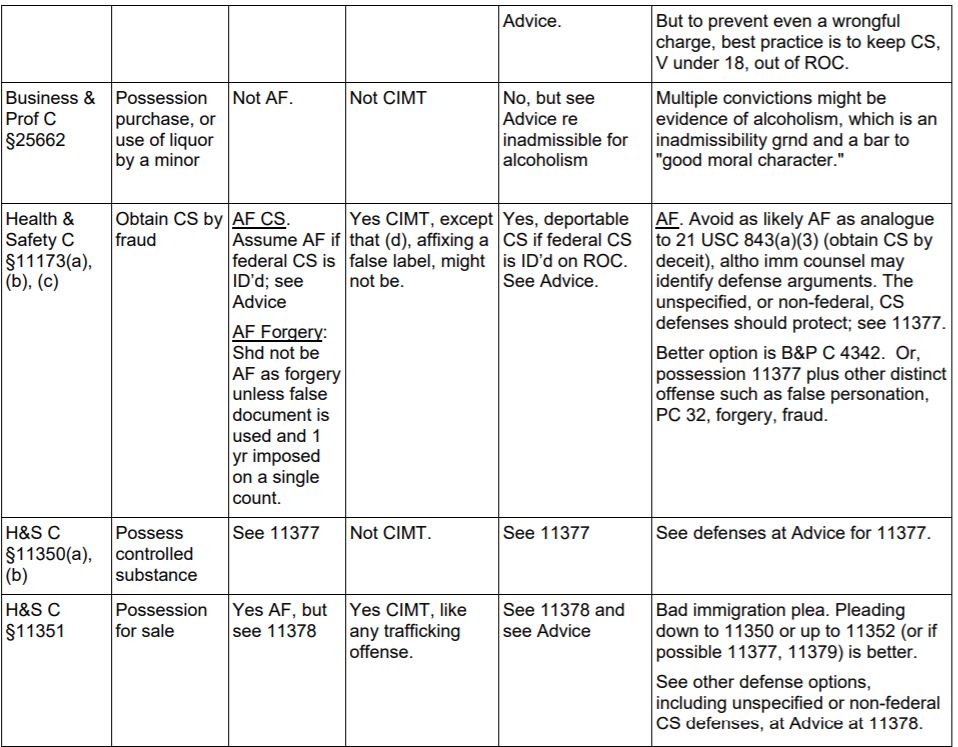
Business & Prof C §25662, §11173(a), (b), (c)
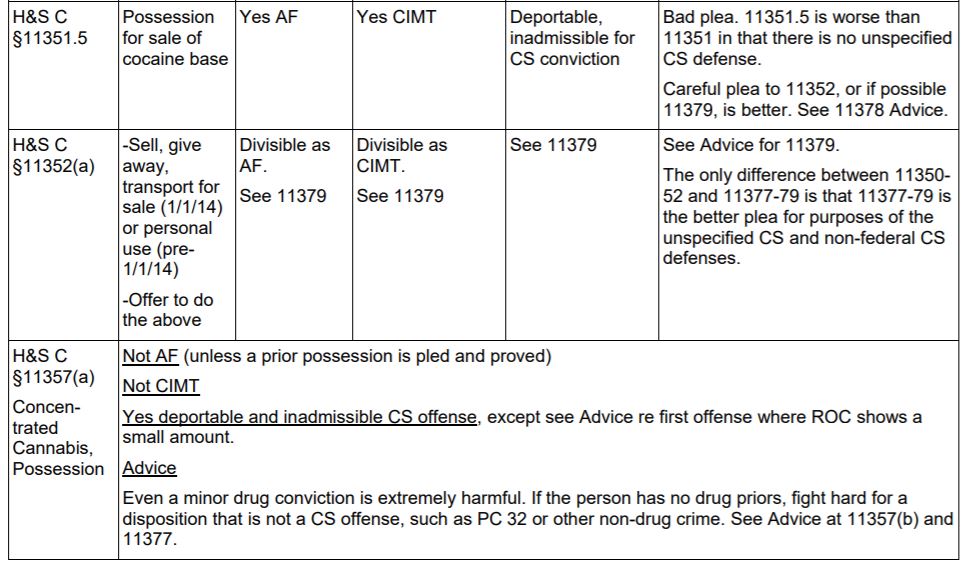
H&S C §11350(a), (b), H&S C §11351, H&S C §11351.5, H&S C §11352(a), H&S C §11357(a), Concentrated Cannabis, Possession
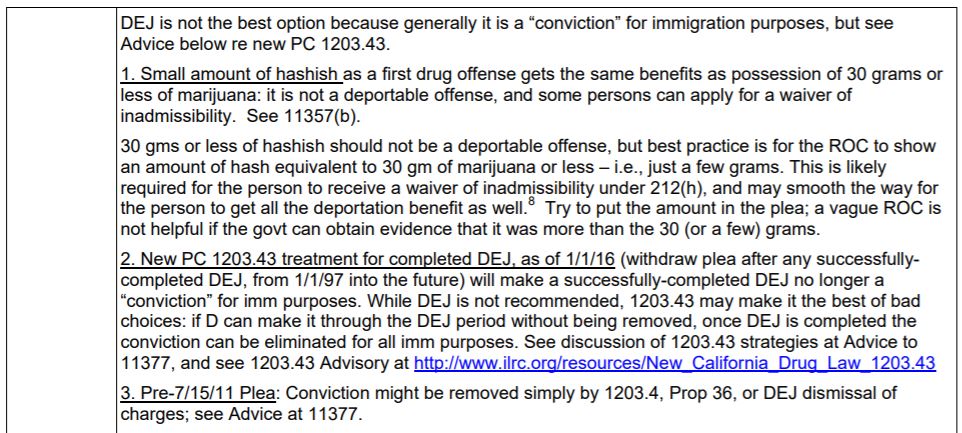
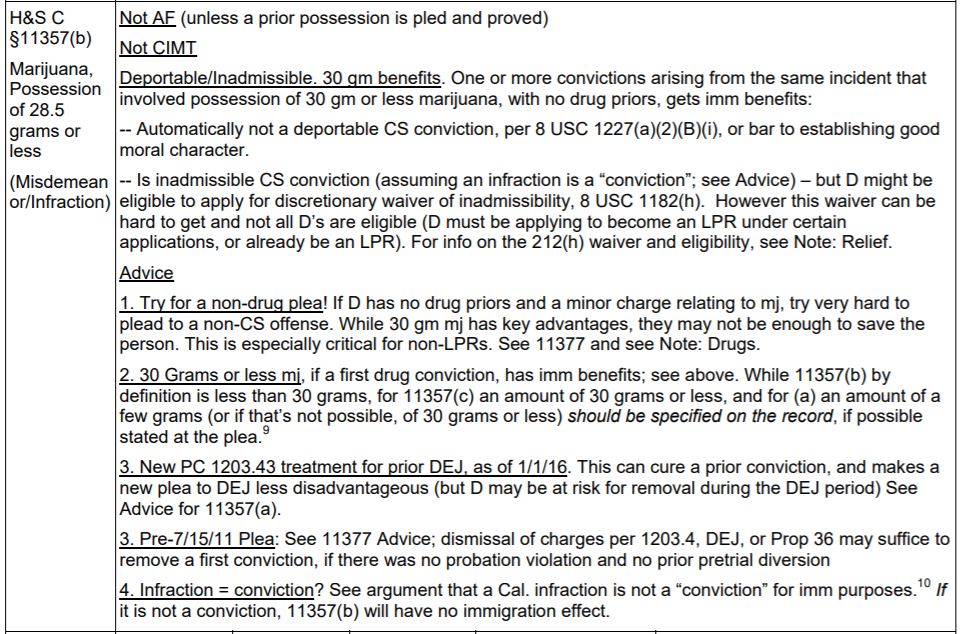
H&S C §11357(b)Marijuana, Possession of 28.5 grams or less (Misdemean or/Infraction)

H&S C, §11357(c)

H&S C, §11358
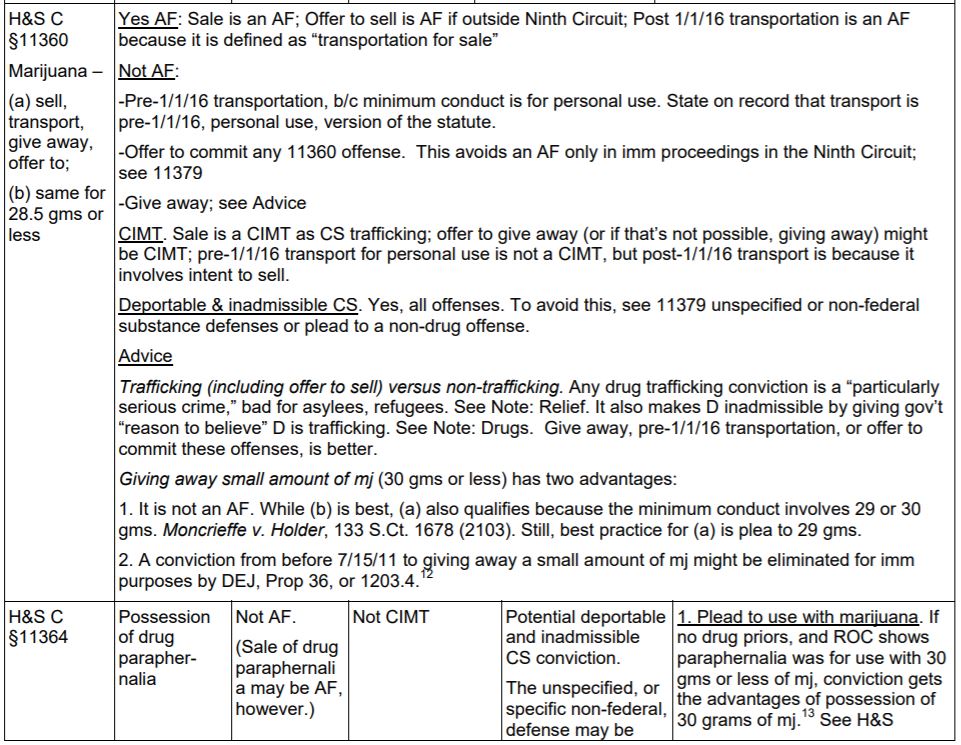
H&S C §11360 Marijuana – (a) sell, transport, give away, offer to; (b) same for 28.5 gms or less, H&S C §11364
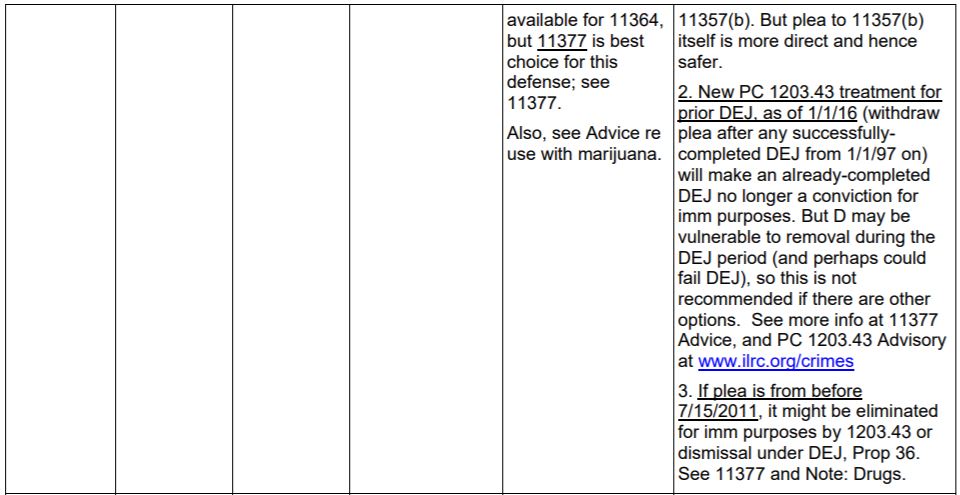
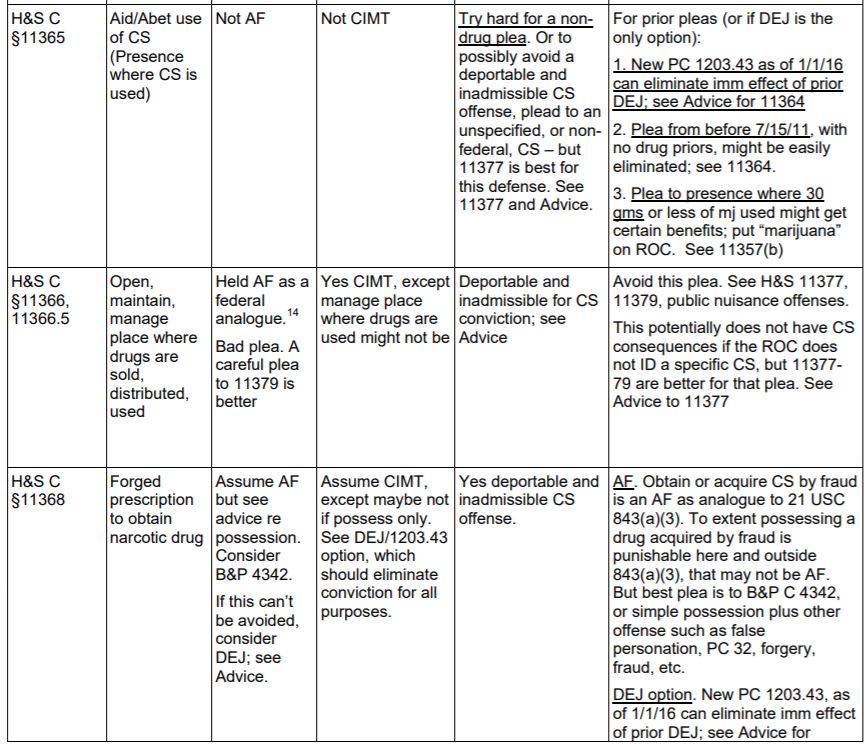

H&S C §11365, H&S C §11366, 11366.5, H&S C §11368
H&S C §11377 Possess a controlled substance
Note: 11350-52 Charges: Follow instructions for 11377-79. Note that 1377-79 is recommended if you use unspecified or non-federal substance defenses. Otherwise offenses are the same for imm purposes.
Not AF. Possession is not an AF unless prior drug offense is pled or proved for a recidivist enhancement, or the possession is of flunitrazepam.
Not a CIMT
Deportable and inadmissible CS conviction. Yes. Consider these defense strategies:
- Avoid a first drug conviction! If this is D’s first CS offense, try very hard to plead to a non-CS offense or other disposition. Consider: PC 32, 459(b), 136.1(b), trespass, or any other less harmful offense, based on D’s individual circumstances. Individual analysis is needed, but in many cases a theft or violent offense is less dangerous than a drug offense. Get expert advice if needed to analyze options. As a first-time minor offender there may be room to bargain, and a first drug conviction is often life-destroying to an immigrant. See Box “Making the Case” at Note: Controlled Substances.
- Avoid a “conviction.” Pretrial diversion (PC 1001, or an informal agreement to fulfill conditions before plea hearing in exchange for a better plea) and delinquency disposition are not convictions. DEJ is a conviction, but it now has some advantages due to new PC 1203.43; see # 4 below.
- Unspecified CS, and non-federal CS, defenses.
To be a deportable or inadmissible CS conviction or a CS agg felony, a state conviction must involve a substance listed in federal drug schedules. Cal drug schedules include some non-federally listed substances. The disparity gives rise to these defenses. For this defense plead to 11377-79 rather than 11350-52 or 11364 if possible.
a. Unspecified CS defense. If the entire ROC refers only to a “controlled substance” as opposed to, e.g., “meth”, 11377-79 is not a CS offense for purposes of deportability. 15 Thus this disposition will not cause an LPR to become deportable. However, under current law the conviction is a CS offense as a bar to relief or admission.16 Thus it will cause an undocumented person, or an already-deportable LPR, to have a drug conviction for purposes of eligibility for relief. The charge, plea colloquy, plea agreement, judgment, factual basis must be clear; watch out for clerk-written notations on forms that refer to the charge, including abstract. See Note: Drug Offenses.
b. Non-federal CS defense. While this may be quite difficult to get, it protects against deportability and bars to relief. Specific plea involving substances such as chorioinic gonadotropin or khat will prevent 11377-11379 from being a deportable or inadmissible CS conviction, or a CS aggravated felony, because these is not on the federal CS list.17
T ese pleas should remain safe even if substances are later added to the federal list, because the lists are compared as of the date of the conviction.18
c. Trafficking. These defenses likely won’t prevent a trafficking conviction (e.g. 11351-52, 11378-79) from being a “particularly serious crime,” which is dangerous for asylees and refugees, or from being a CIMT. It may not prevent the person from being inadmissible because DHS has reason to believe he or she engaged in trafficking, because while that requires a federally-defined CS, it is a fact-based inquiry not limited to the ROC. Offer to give away or furnish is a better plea than sale for this purpose, but all are dangerous. See Advice to 11379.
- New PC 1203.43 treatment for DEJ, as of 1/1/16 (withdraw plea after any successfully-completed DEJ from 1/1/97 and after)
Here is a summary of the law. See a 1203.43 Advisory for defenders, sample moving papers, and other resources at www.ilrc.org/resources/New_California_Drug_Law_1203.43.
Because immigration law uses a different definition of conviction than California, DEJ generally is a conviction for imm purposes even after dismissal of charges under PC 1000.3. New 1203.43 creates a simple procedure to eliminate a successfully-completed DEJ as an immigration “conviction.”19 See materials listed above for aids in obtaining this relief for persons who already have completed DEJ. The 1203.43 application can be granted without a hearing, based solely on the court’s own record that it dismissed D’s charges under PC 1000.3 (or if that record no longer exists, based on other evidence set out at 1203.43(b)).
For new charges, DEJ is not a recommended plea, but it may be the best of bad alternatives. It is true that DEJ granted after 1/1/16 will continue to be amenable to 1203.43 upon completion, and once 1203.43 is granted it will not be a conviction. But D may be vulnerable to removal during the minimum 18-month DEJ period, if ICE locates him and puts him in proceedings during that time. Imm counsel have b arguments that removal proceedings should be continued to allow for completion of DEJ (see DEJ Advisory, cited above), but immigrants often are unrepresented. For this reason, as well as the possibility that D will not succeed in completing the program, a non-drug plea is best.
DEJ is far preferable to a regular CS conviction, however. If DEJ is taken, request 18 rather than 36 months (unless that is not appropriate for D). Advise D to retain imm counsel to be ready in case he is placed in removal proceedings during the DEJ period. Advise D that it is critical to complete the DEJ program, stay out of further trouble with the law, refrain from leaving the U.S., and avoid immigration authorities until 1203.43 is granted.
There are two strategies that will prevent an immigrant D from being vulnerable during the DEJ period. First, an LPR or refugee who is not otherwise deportable and who pleads to an unspecified CS is not deportable for a CS conviction, and so is not vulnerable during the DEJ period. Under current law, this strategy will not protect an immigrant who must apply for relief, however. See Part 3, above. Second, DEJ is not a conviction if the only penalty is an unconditionally suspended fine; see next section.
See further discussion of these issues at 1203.43 materials in the Advisory cited above. If there are problems in your area with implementation of new 1203.43, contact [email protected].
- DEJ with unconditionally suspended fine is not a conviction for imm purposes, per Ninth Circuit.20
If the court declines to unconditionally suspend the fine, see if the court might agree to delay making an order regarding the fine until later in the DEJ period. This may be difficult to obtain, but if obtained it could protect D until the fine is imposed. See also Part 4, above.
- If conviction relating to federally-defined CS can’t be avoided, note that a few types of imm status and relief from removal are not automatically barred by a possessory (as opposed to trafficking) conviction, for example asylum, T and U visa, and in some cases LPR cancellation. See Note: Relief Toolkit for more information. D should seek imm counsel.
H&S C §11378
Possess CS for sale
AF: Yes AF, unless unspecified or non-federal CS defense applies; see 11377. This is a very bad plea for immigrants. To avoid AF plead to a non-drug offense if possible (see 11377 Advice); plead down to 11377; or advise D about pleading up to 11379 offer to give away (or if necessary, offer to sell), which is not an AF in imm proceedings arising within the Ninth Circuit.21 Pleading up is counter-intuitive but may be necessary for immigrant D’s, if the person prioritizes remaining in the U.S. It can be IAC to fail to advise and consider the 11352/11379 option in an 11351/11378 charge for a noncitizen D.22
CIMT: Yes as trafficking, regardless of unspecified or non-federal CS.
Deportable and inadmissible CS conviction: Yes, unless this is prevented by the unspecified or nonfederal CS defense. But it is far better for immigration purposes to use that defense with 11379 offering to, than 11378.
Inadmissible for reason to believe. The non-specific, or specific non-federal, CS defense may prevent this from being an AF or deportable or inadmissible CS conviction, but ICE still may collect evidence on the substance for the fact-based ground of inadmissibility based on “reason to believe” trafficking. See discussion at 11379.
Particularly serious crime (PSC): Trafficking is a PSC, very bad for asylees and refugees. See 11379 and see Note: Relief Toolkit.
H&S C §11379(a)
-Sell
-Give away
-Transport for sale (1/1/14 statute)
-Transport for personal use (pre
Divisible as AF:
Yes AF: Sell, give away, and after 1/1/14, transport for sale are AFs. This is not true if the unspecified CS or specific non-federal CS defense applies; see Advice.
Not AF: Pre-1/1/14 transport is not an AF; offer to transport is best option. Offer to commit any 11352/11379 offense is not AF, but only in imm proceedings arising in the Ninth Circuit. (Offer to give away is better than offer to sell; See Advice.) Unspecified, or non-federal, CS defense prevents an AF
CIMT: Sale and 1/1/14 transportation are CIMTs b/c they involve trafficking. So is offer to commit these, and distribution might be. Pre-1/1/14 transportation is not a CIMT, because it is for personal use. Unspecified CS and specific non-federal CS defenses do not prevent CIMT.
Deportable and inadmissible CS conviction: Yes, all of these offenses, including transportation, are deportable and inadmissible CS convictions unless the unspecified or non-federal substance defense
applies. See Advice
Advice
1. Non-specific CS, and specific non-federal CS, Defenses. Because Cal drug schedules contain some substances that don’t appear on federal drug schedules, a plea to an unspecified “controlled substance,” or to a specific substance not on the federal list, can prevent 11379 from being a deportable or inadmissible CS conviction, or a CS agg felony. See discussion at 11377. Note that these defenses do not necessarily prevent a trafficking conviction from being a CIMT or particularly serious crime, or inadmissible for “reason to believe trafficking,” because these penalties don’t require a federally listed substance and/or can involve evidence from outside the ROC; see below.
2. Inadmissible for “reason to believe” trafficking. Sale, post-1/1/14 transport, and offer to do these provide ICE with “reason to believe” D was trafficking, which is a very bad inadmissibility ground. These are very bad pleas for an undocumented, asylee, refugee, or other non-LPR defendant. Offer to give away is somewhat better than offer to sell; see below. While the non-specific or non-federal CS defenses prevent the plea itself from establishing inadmissibility based on reason to believe, ICE may be able to obtain evidence elsewhere to prove that a federally-listed CS was involved, for purposes of this fact-based ground.
3. PSC for refugees, asylees. Conviction for commercial trafficking (sale, post 1/1/14 transport, or offer to do these) is a particularly serious crime (PSC). Asylees and refugees can lose their status and be removed based on this conviction, except in the rare case where there are extraordinary equities and these factors: amount was very small, defendant was peripheral to scheme, and no minors involved. Offer to give away is better than offer to sell for this purpose. Non-specific federal, and unspecified, CS defenses don’t work here. See Note: Relief.
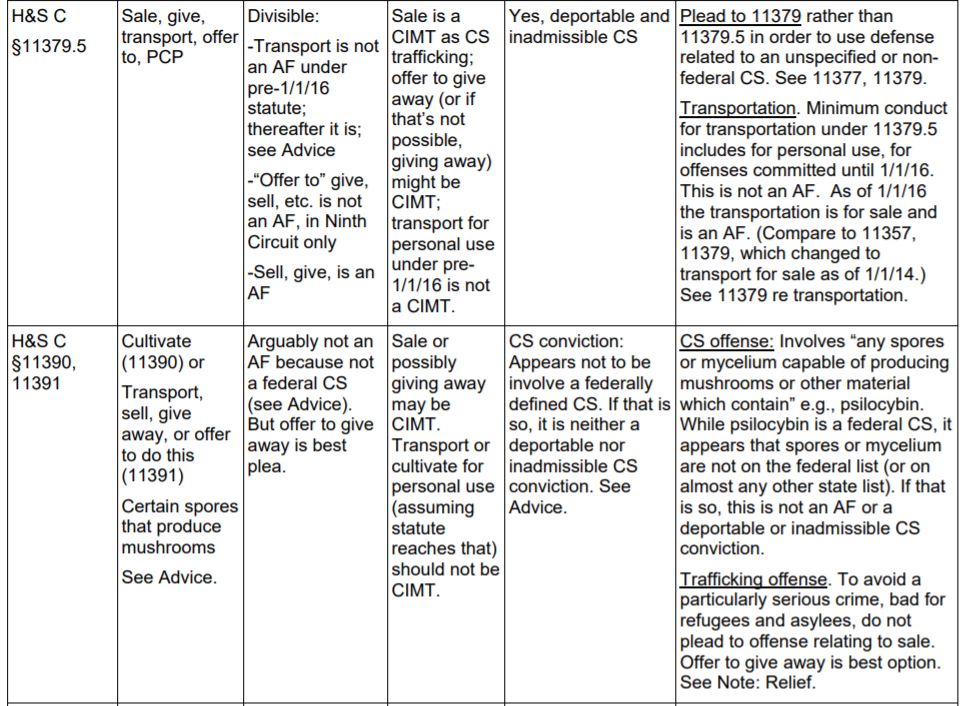
H&S C §11379.5 | H&S C §11390,

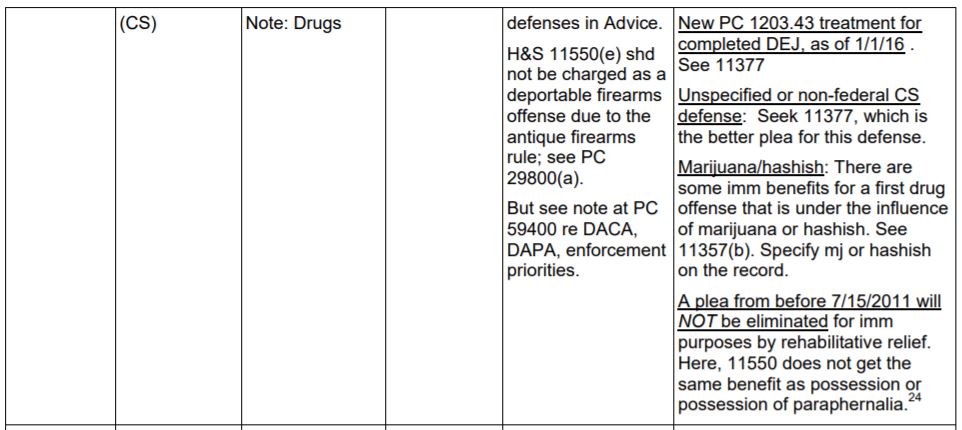
H&S C
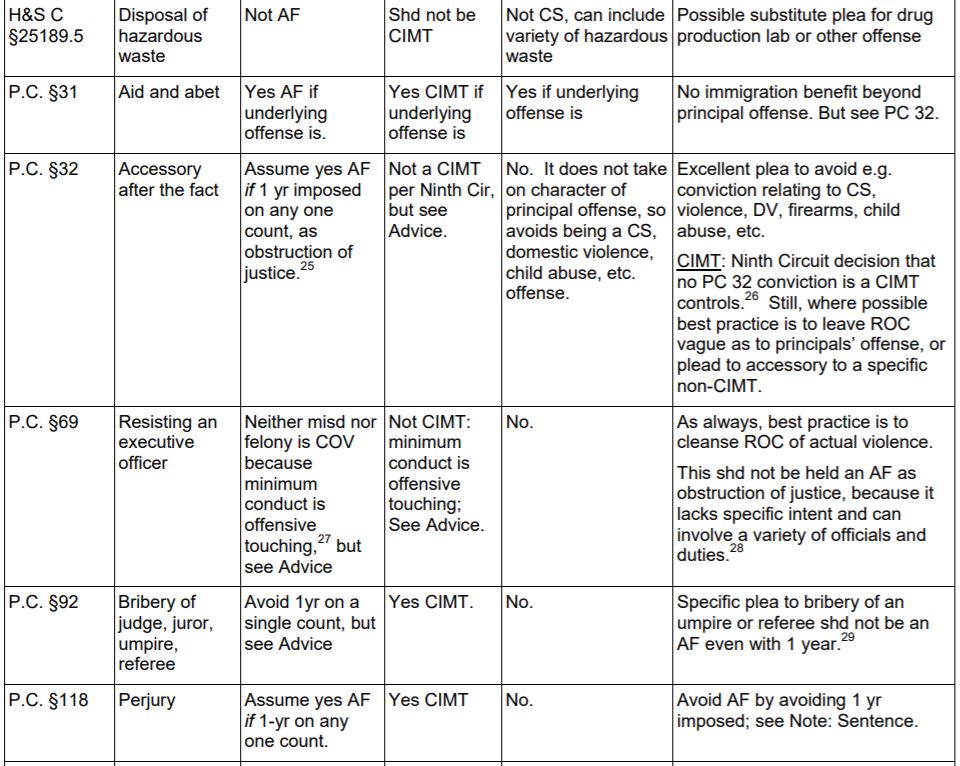
H&S C §25189.5, P.C. §31, P.C. §31, P.C. §69, P.C. §92, P.C. §118

P.C. § 135
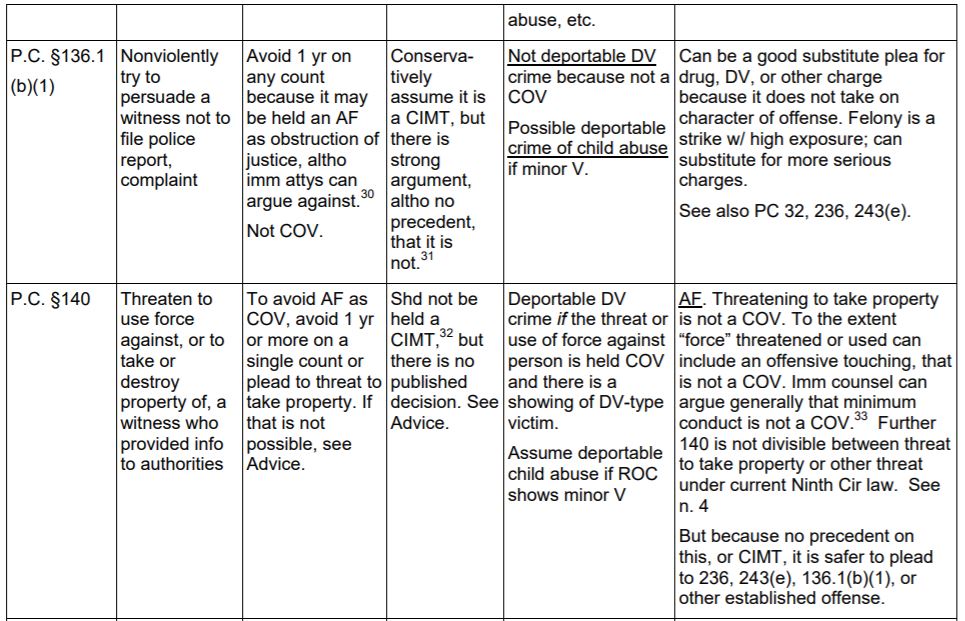
P.C. §136.1 (b)(1), P.C. §140
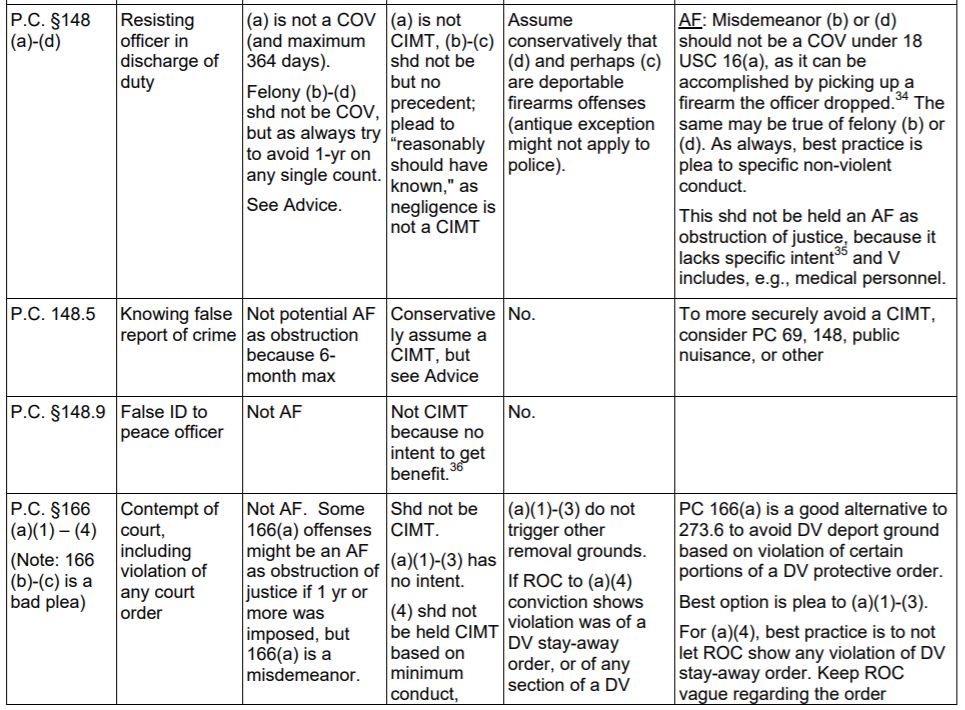
P.C. §148 (a)-(d), P.C. 148.5, P.C. §148.9, P.C. §166 (a)(1) – (4), (Note: 166, (b)-(c) is a bad plea)
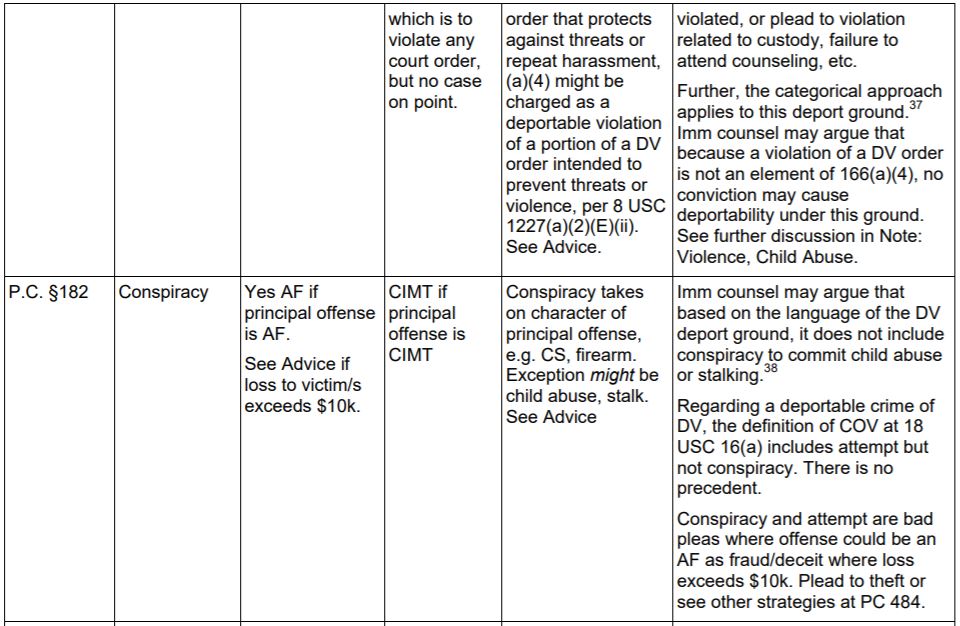
P.C. §182

P.C. §186.22(a), P.C. §186.22(b), (d)
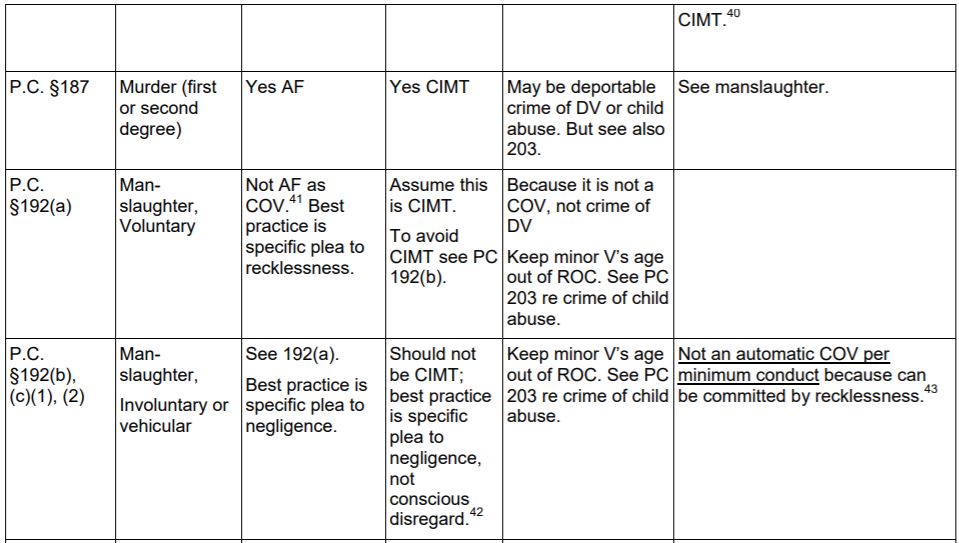
P.C. §187, P.C. §192(a), P.C. §192(b), (c)(1), (2)

P.C. §203, P.C. §207

P.C. §236, 237(a)
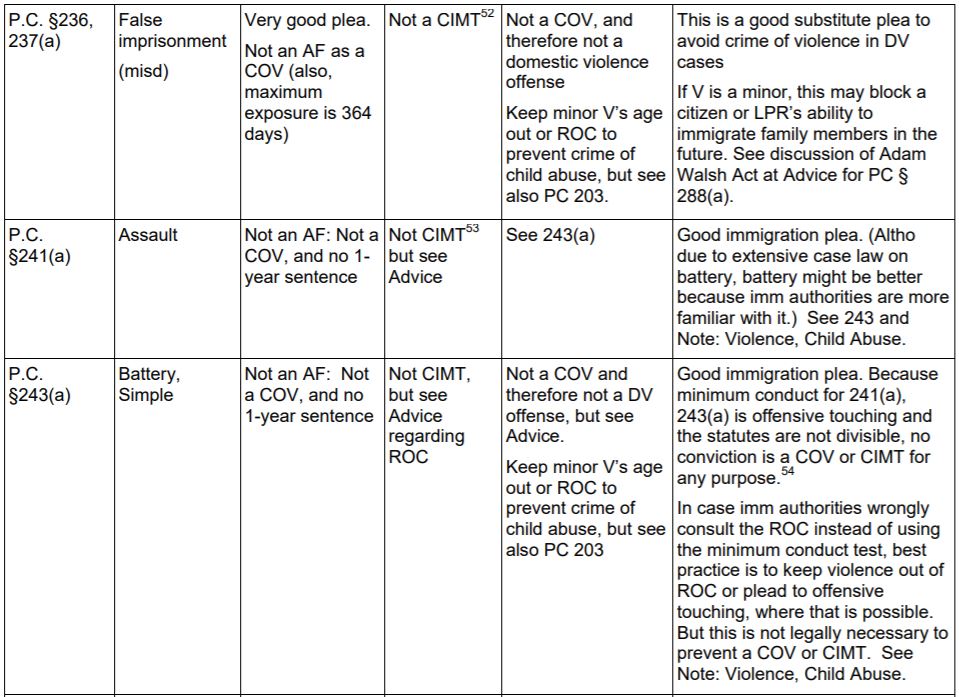
P.C. §236, 237(a), P.C. §241(a), P.C.§243(a)
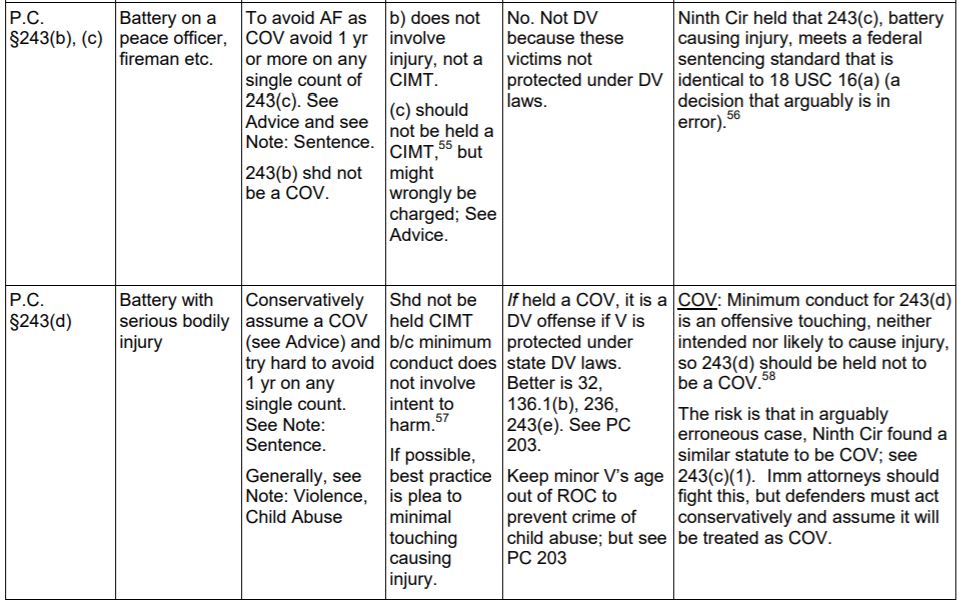
P.C. §243(b), (c), P.C. §243(d)

P.C. §243(e)(1)

P.C. §243.4(a) and (e), P.C. §245(a)(1)- (4)(Jan 1,2012)

P.C. § 246, P.C. §246.3(a), (b)
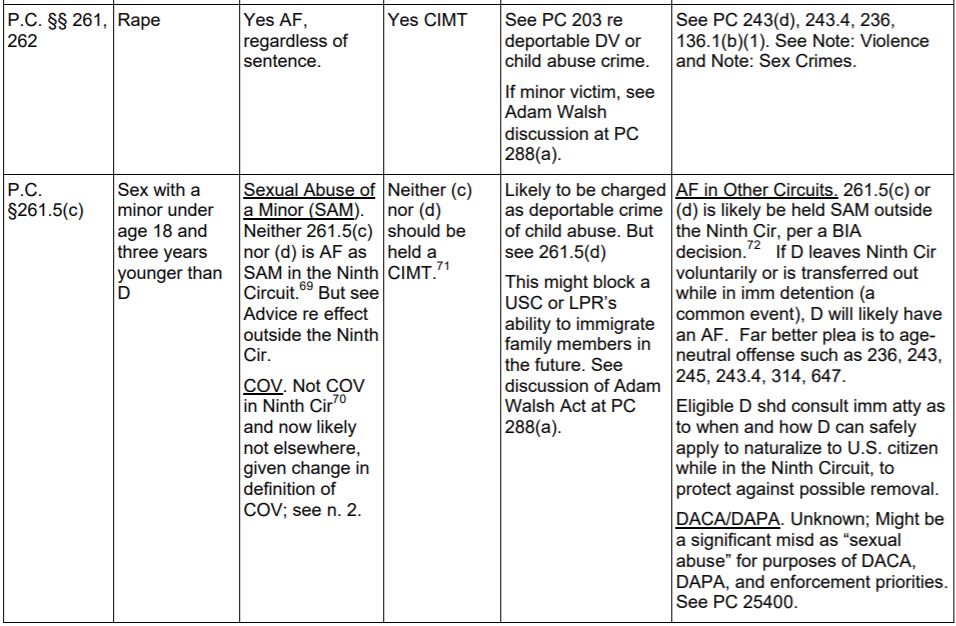
P.C. §§ 261, 262, P.C., §261.5(c)
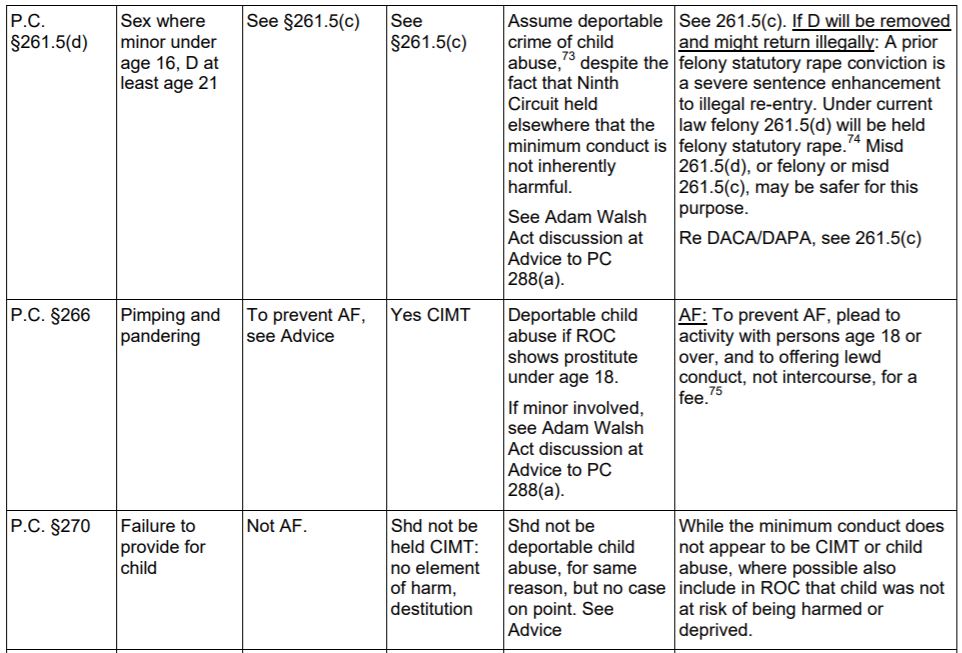
P.C. §261.5(d), P.C. §266, P.C. §270
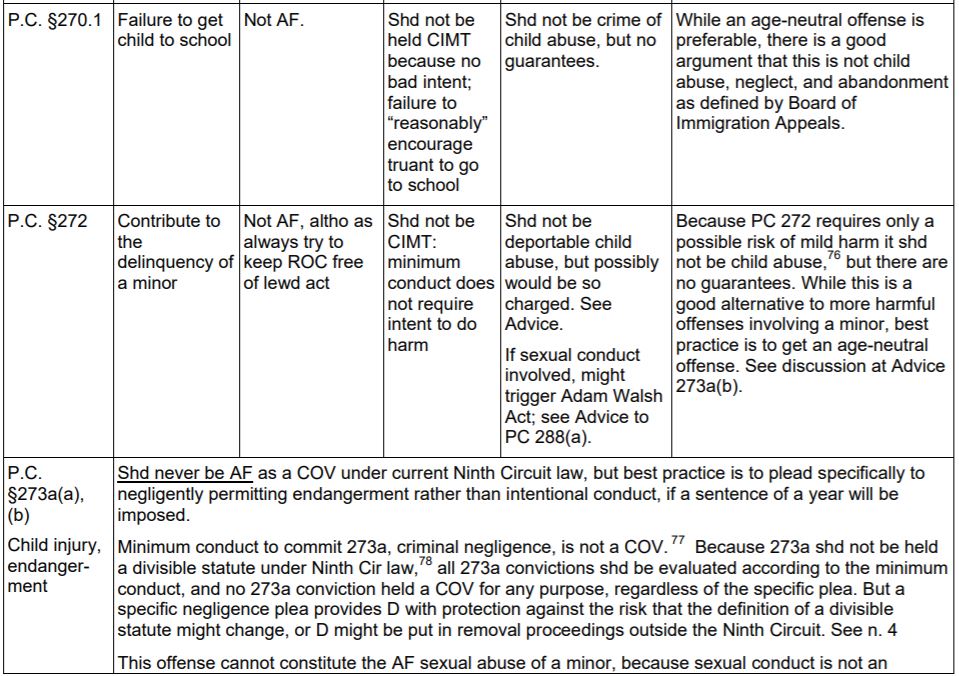
P.C. §270.1, P.C. §272, P.C., §273a(a),(b)Child injury,endangerment
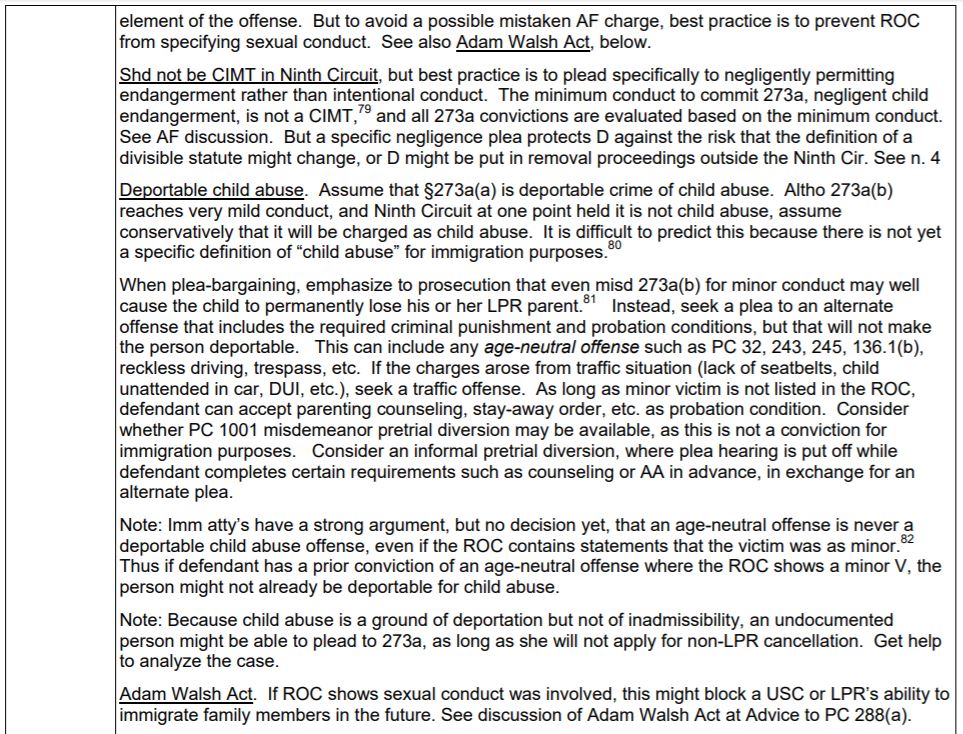

P.C. §273d, P.C. §273.5

P.C. §273.6, P.C. §281
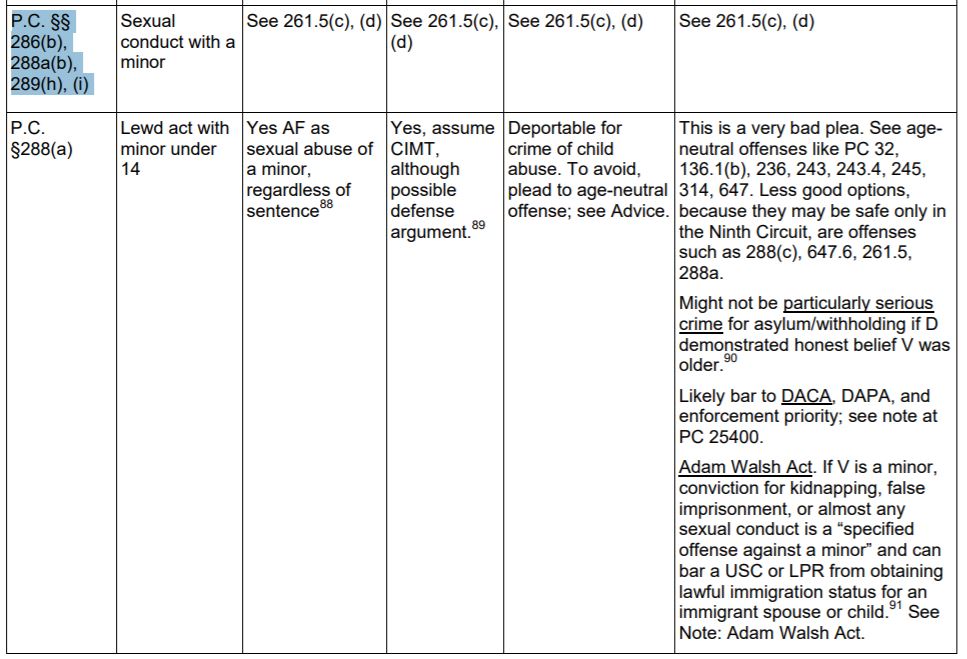
P.C. §§ 286(b), 288a(b), 289(h), (i), P.C. §288(a)
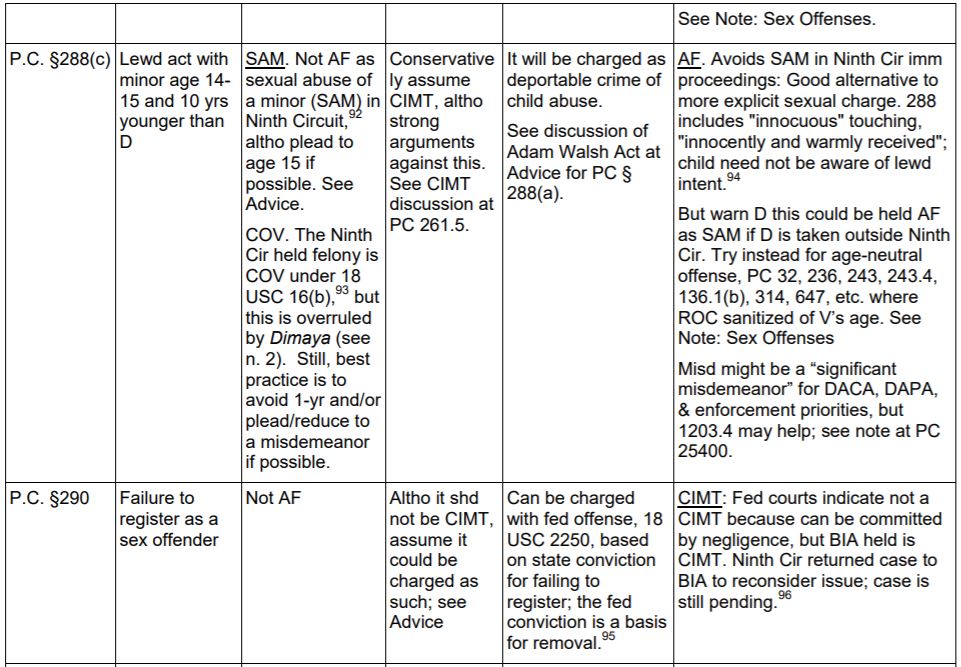
P.C. §288(c),P.C. §290
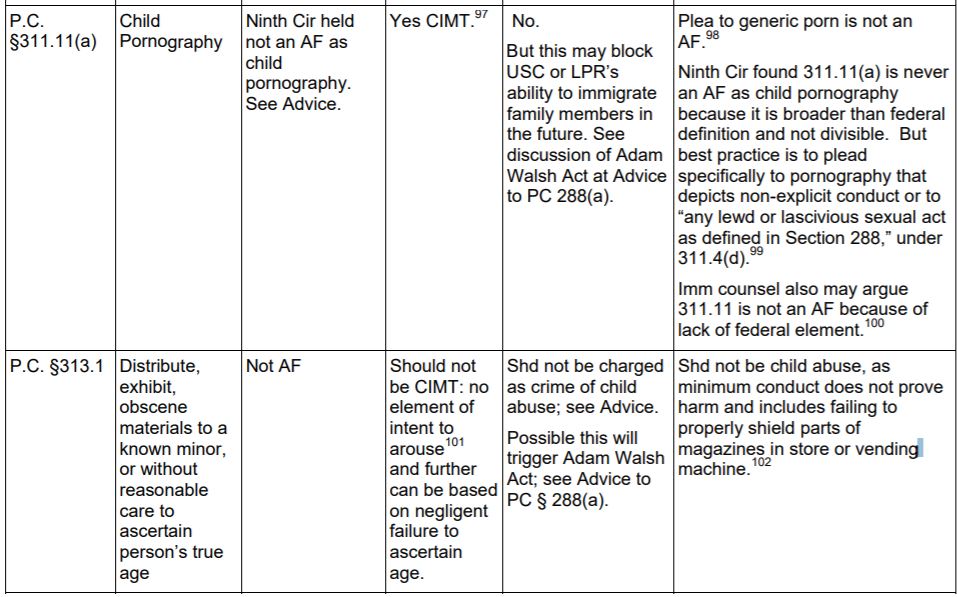
P.C. §311.11(a), P.C. §313.1
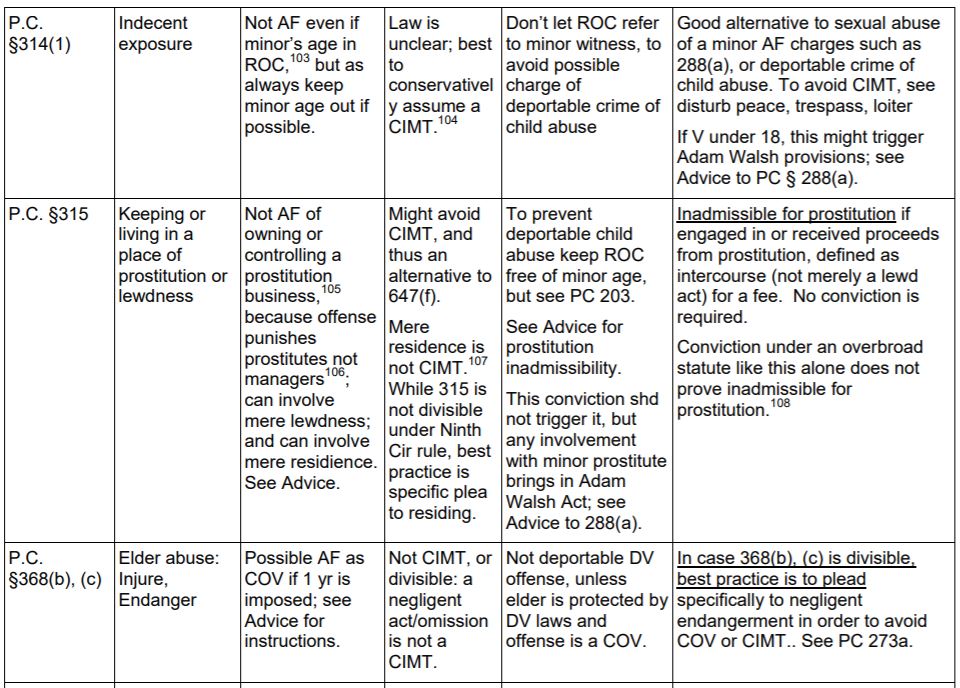
P.C. §314(1), P.C. §314(1), P.C. §368(b), (c)
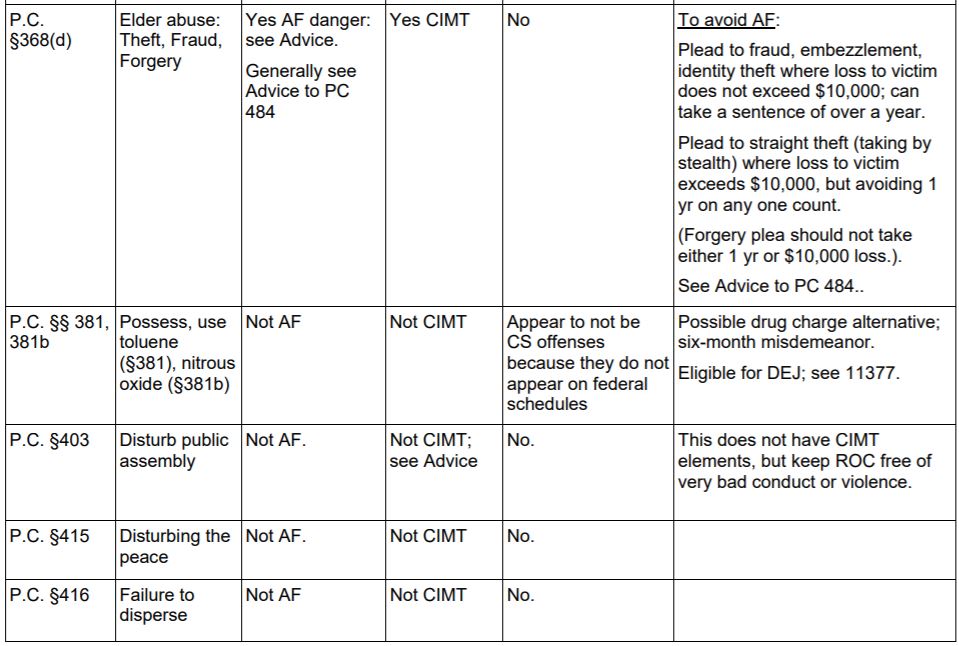
P.C.§368(d), P.C. §§ 381, 381b, P.C. §403, P.C. §415, P.C. §416

P.C.§417(a)(1) Nonfirearm(2) Firearm, P.C. § 417.3, 417.8
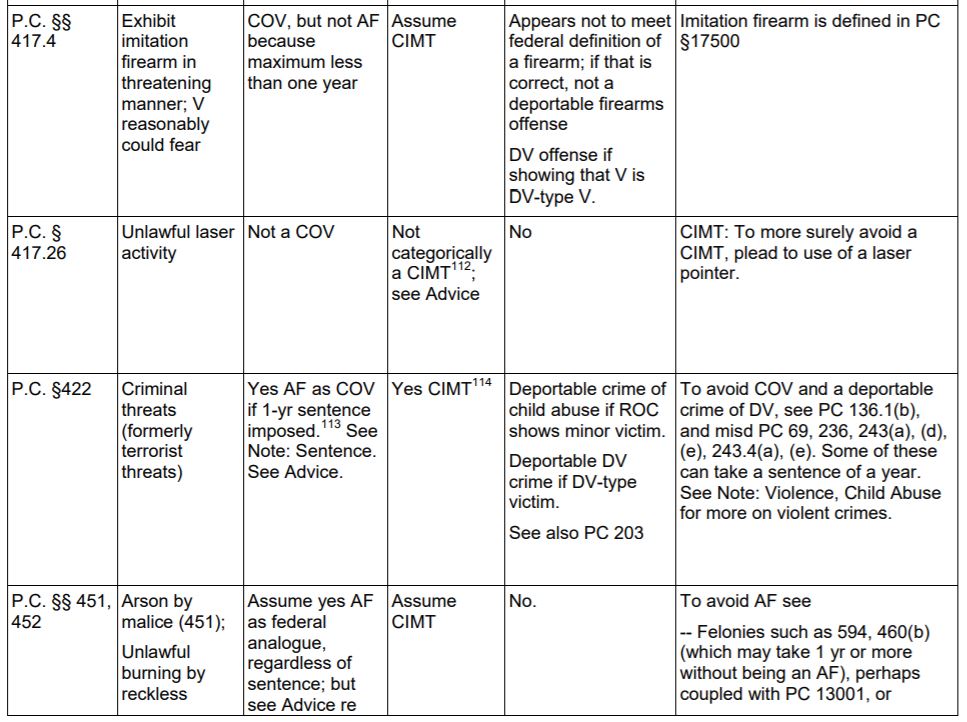
P.C. §§ 417.4, P.C. § 417.26, P.C. §422, P.C. §§ 451, 452

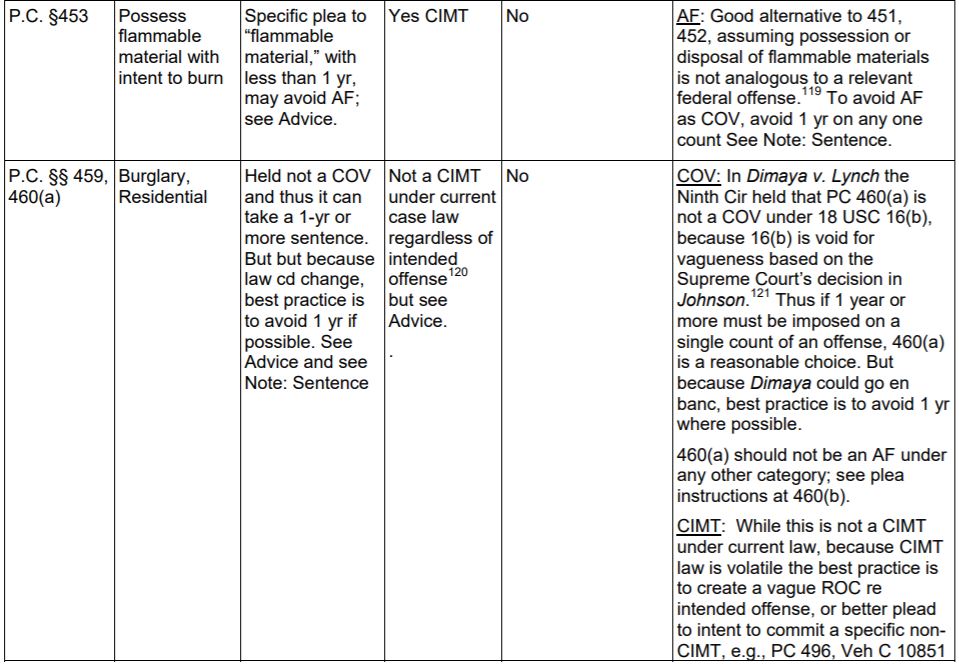
P.C. §453, P.C. §§ 459, 460(a)

P.C. §§ 459, 460(b), P.C. 459.5, P.C. §466
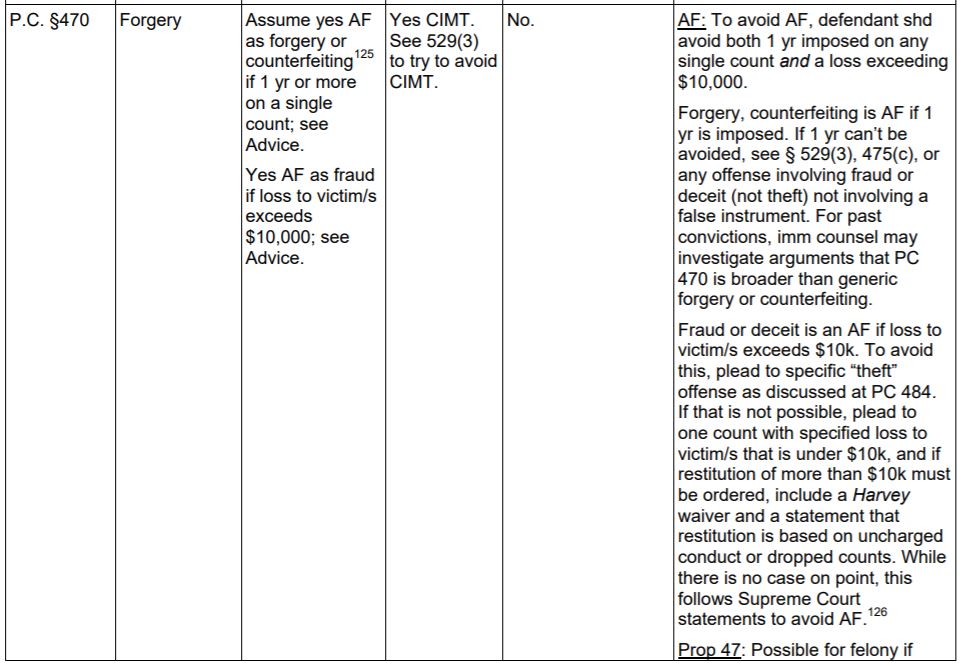
P.C. §470

P.C. §471.5, P.C. § 475(c), P.C. § 476(a)
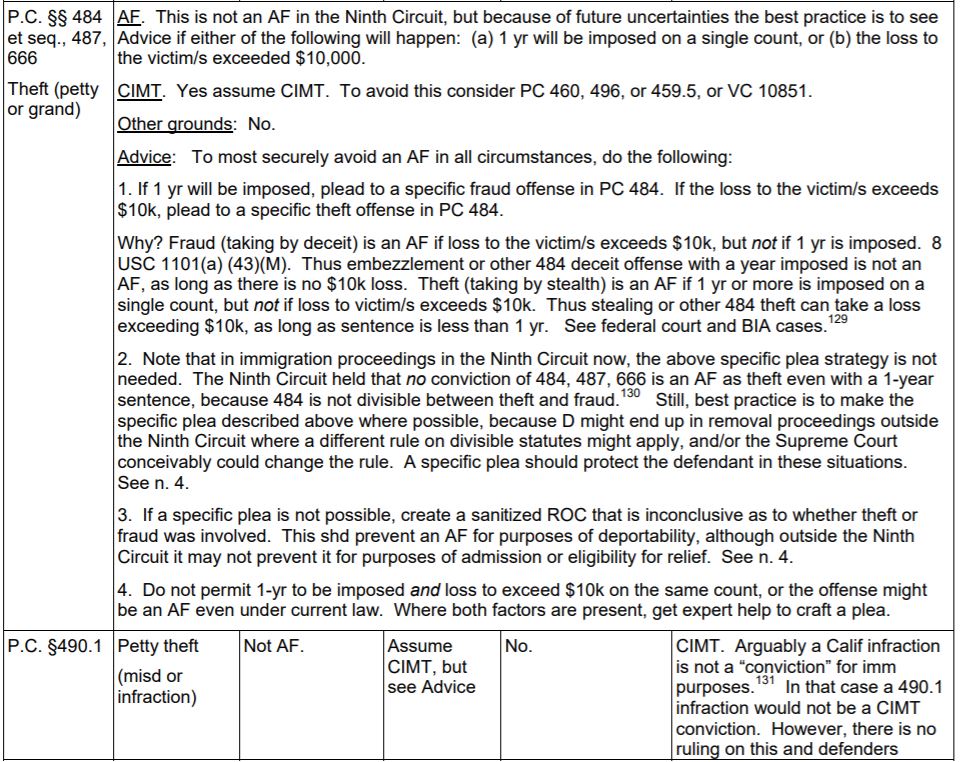
P.C. §§ 484 et seq., 487, 666 Theft (petty or grand), P.C. §490.1

P.C. §§ 496,496a, 496d, P.C. §§ 499,499b
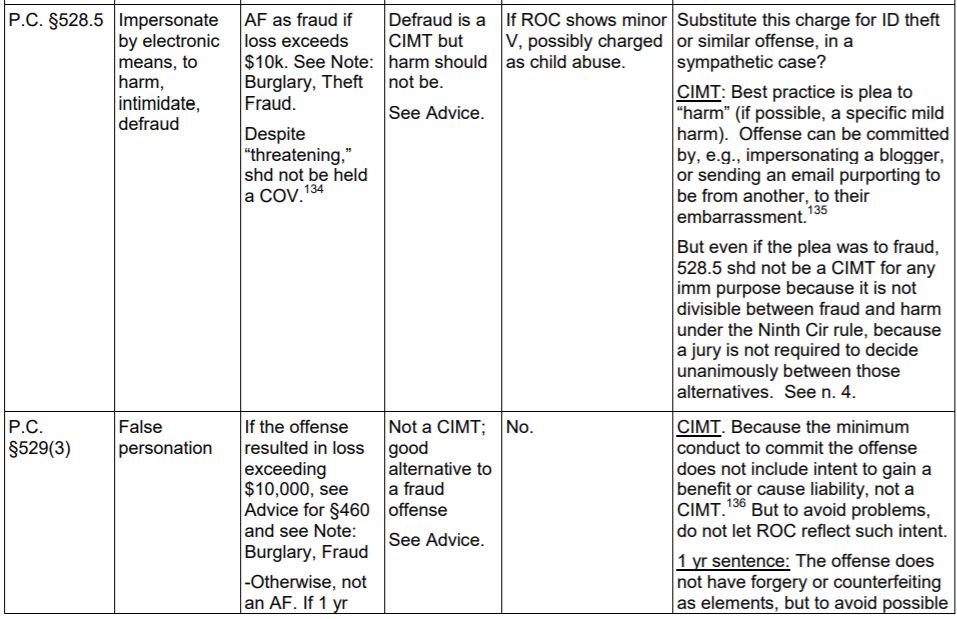
P.C. §528.5, P.C. §529(3)

P.C. §529.5(c)
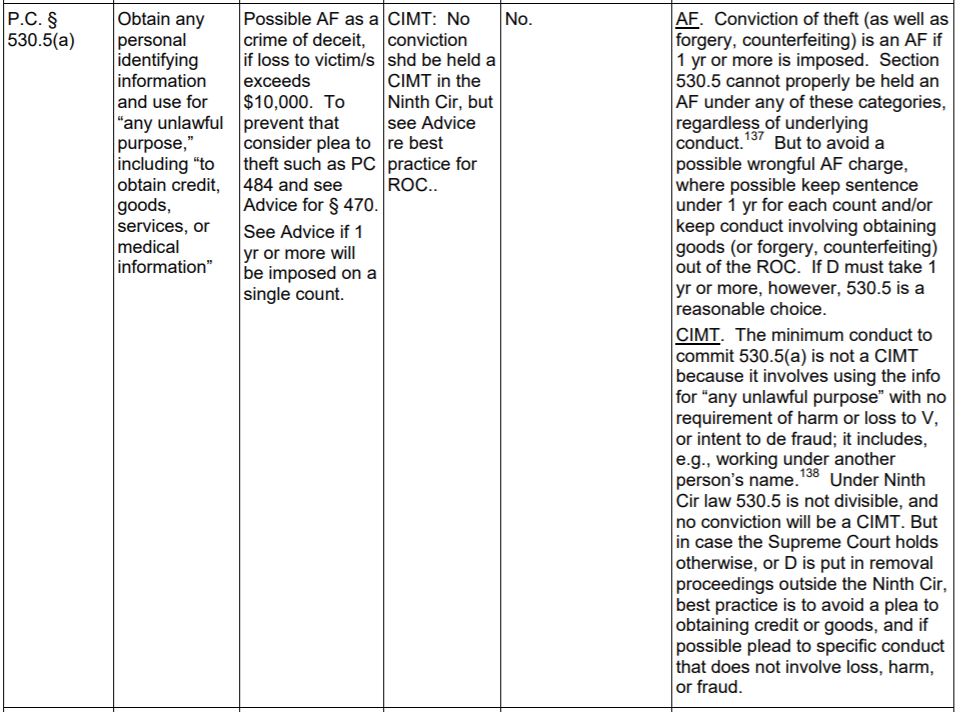
P.C. §530.5(a)
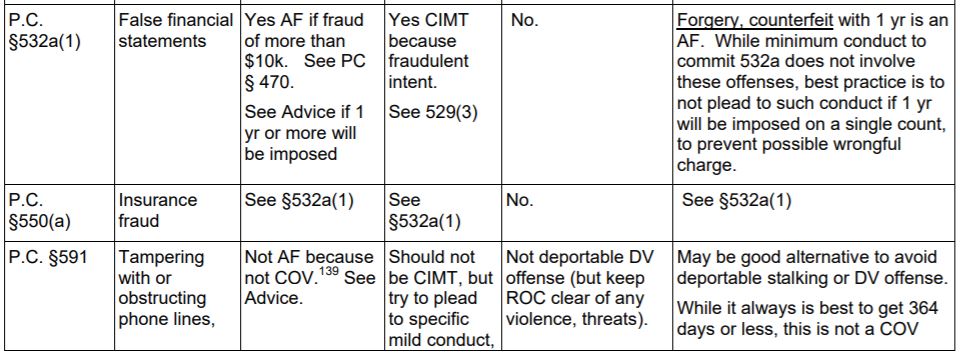
P.C.§532a(1), P.C. §550(a), P.C. §591

P.C. §591.5
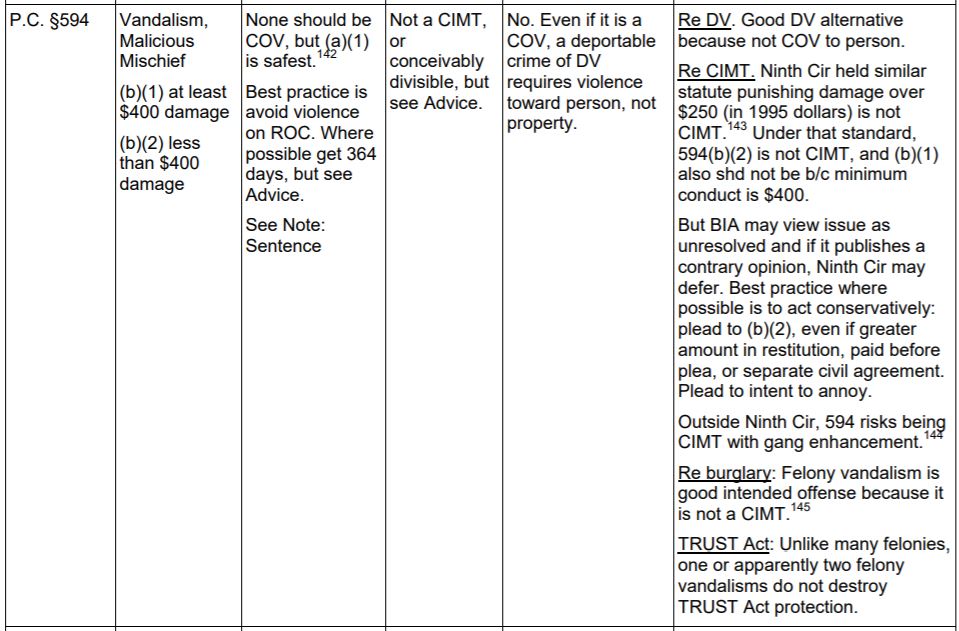
P.C. §594
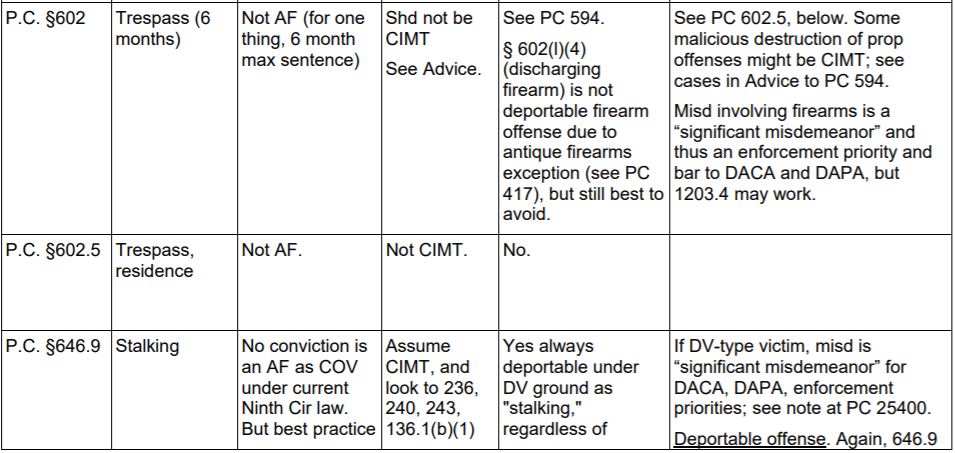
P.C. §602, P.C. §602.5, P.C. §646.9
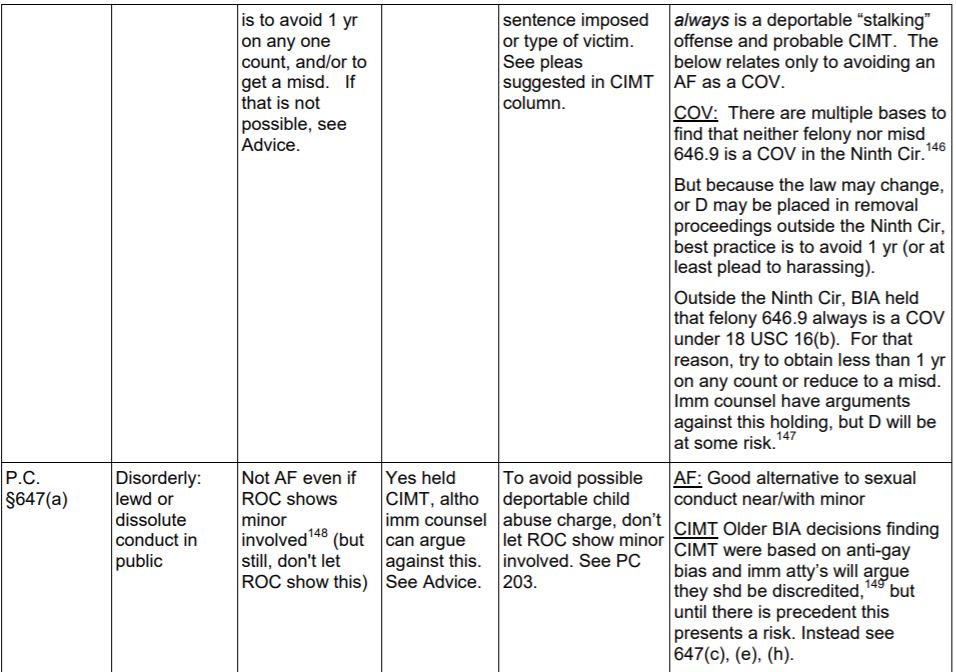
P.C. §647(a)

P.C.§647(b), P.C. §647(c), (e), (h), P.C. §647(f), P.C. §647(i)
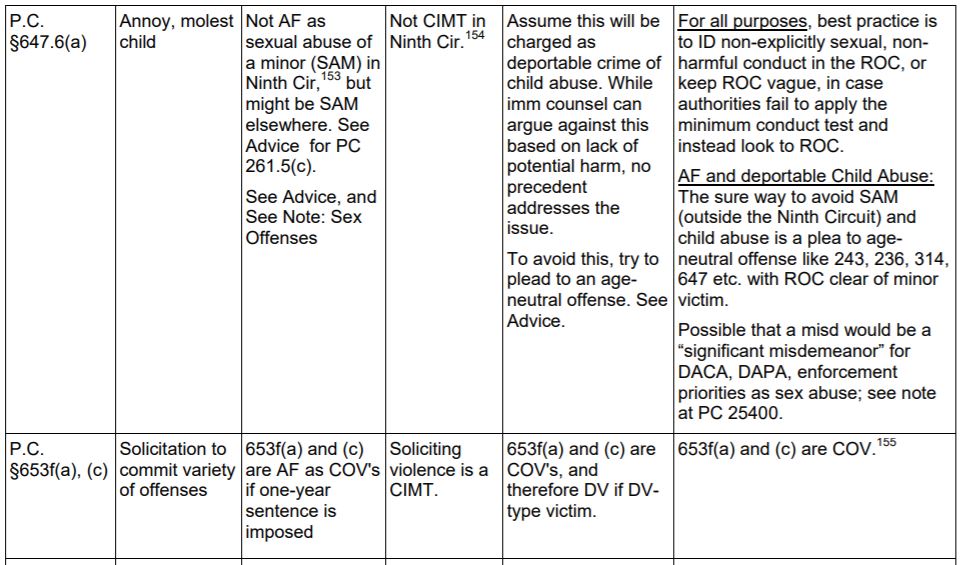
P.C.§647.6(a), P.C. §653f(a), (c)

P.C.§653f(d), P.C. §653k (repealed), P.C. §653m(a), (b)
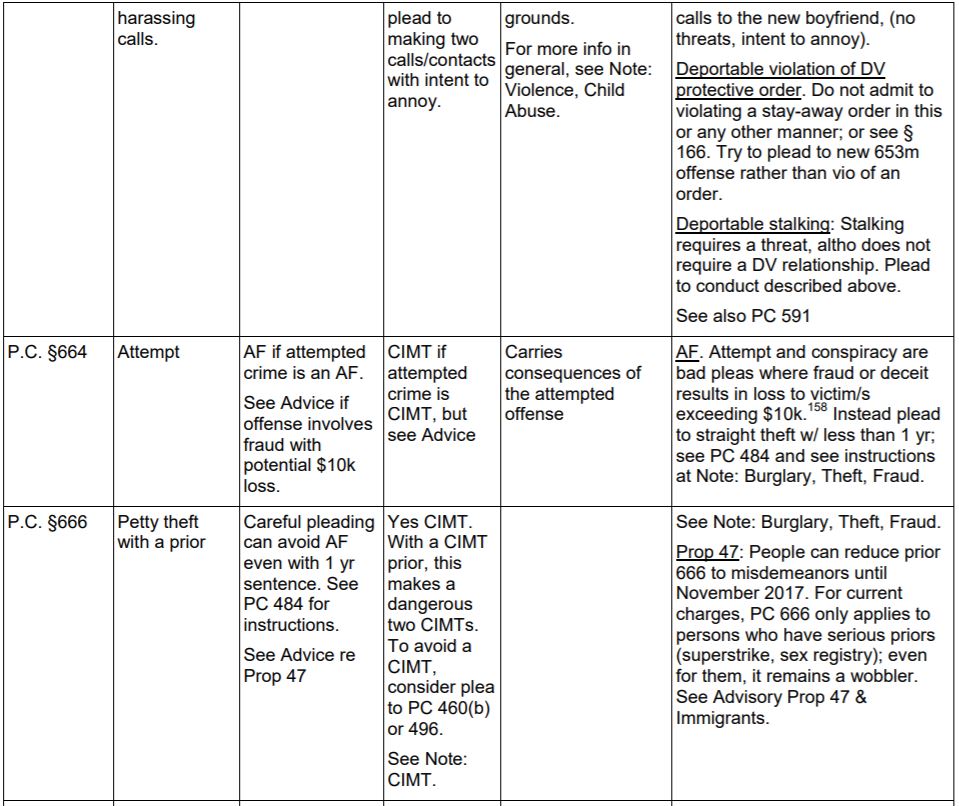
P.C. §664, P.C. §666

P.C.§1320(a), P.C. §§ 1320(b), 1320.5 P.C. §4573

P.C. §4573.8, Former P.C. §12020 (Repealed 1/1/12)

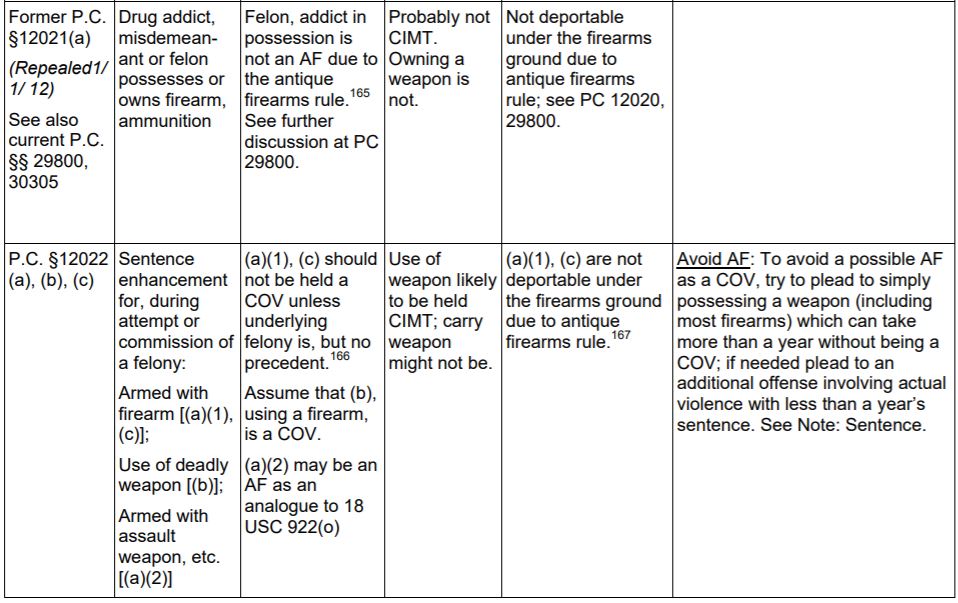

Por; ilrc.org